The landscape lens is a fascinating look through the history of lens design. We go from a very primitive single lens design that made careful considerations of astigmatism to achieve maximum performance, with incremental improvements, finally to a lens that made strategic use of a new cemented lens configuration that was groundbreaking for its time.
Introduction to the landscape lens
By No machine-readable author provided. Janeznovak assumed (based on copyright claims). – No machine-readable source provided. Own work assumed (based on copyright claims)., CC BY 2.5, Link
Landscape lenses aren’t designed in this way today, however with the ever-growing need for complex optical systems, the concepts that can be learned from the landscape lens can be used in any lens system, because an optical system with multiple lenses still has single lenses amoungst them.
Quick summary, the early lens designs like the landscape lens developed on two principles:
- The improvement of the aberrations by changing the lens shape
- The offset of aberrations by placing opposing elements in the lens system
Two concepts that can be used today.
Let’s take a walk through the early lens design history and the evolution of lenses as people learned from each other and developed concepts and methods to improve their lens design.
The Wollaston Meniscus: The first landscape lens (1804)
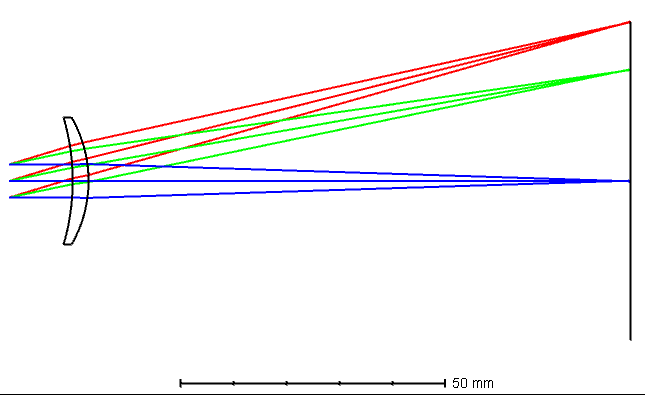
The method of lens design for the Wollaston landscape was to:
- Minimize the field curvature of the lens
- Find the best corrected astigmatism by exploring the relationship between the aperture and the lens shape of the singlet
I’ve designed the Wollaston meniscus landscape for a FOV of 60 degrees, and a focal length of 100mm. The F-number for the lens is F16, which is pretty slow. Let’s take a look at the performance of this lens.
The lens design results of the Wollaston landscape lens
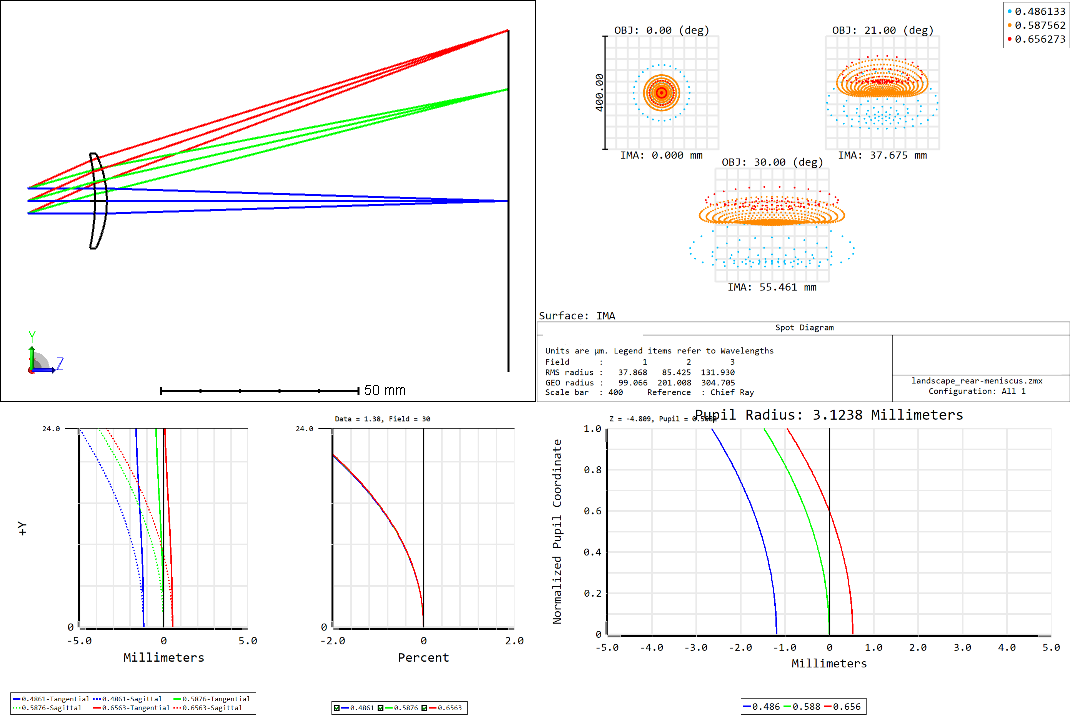
Top left: Lens diagram. Top right: Spot diagram. Bottom (left to right): The field curvature, distortion, and spherical aberration.
What do you see? I see:
- The astigmatism is balanced, as best is can be, although it is still pretty bad
- The field curvature is not good (the Petzval sum is large)
- The distortion is corrected the best it can, notice that the symmetry is low so it can’t be corrected
- The chromatic aberration is pretty bad, but again there is no way to correct this
As an aside, William Hyde Wollaston, the inventor of the first landscape lens, is an English chemist and physicist that is primarily known for his work in chemistry (like processing platinum!), but also made very important optical discoveries. Not only lens design, but prisms, reflecting goniometer, and observing the solar spectrum. In 1812, he developed the meniscus lens for the camera.
By looking at the properties of the Wollaston landscape closely, history tried to improve the lens design. The landscape lens evolved many times over the years, so let’s break down the process with modern tools.
Below, we will start to compare the Wollaston landscape lens with other lenses. I will keep the FOV of 60 degrees for all lenses, and the focal length will be 100mm for all. The F-number will change depending on the lens.
Let’s dive in!
The Chevalier landscape: The doublet for colour correction (1821)
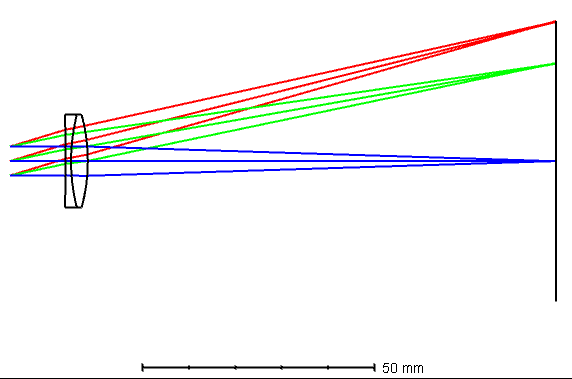
Charles Chevalier designed an achromatic doublet landscape lens in 1821. He simultaneously improved the astigmatism and corrected for the colour by using a negative flint lens and a positive crown lens. However, since the aperture of the system is far away from the lens, there was a lot of distortion, even compared to Wollaston’s landscape lens.
I’ve designed the Chevalier achromatic landscape for a FOV of 60 degrees, and a focal length of 100mm. The F-number for the lens is F16, which is pretty slow. Let’s take a look at the performance of this lens.
The lens design results of the Chevalier landscape lens
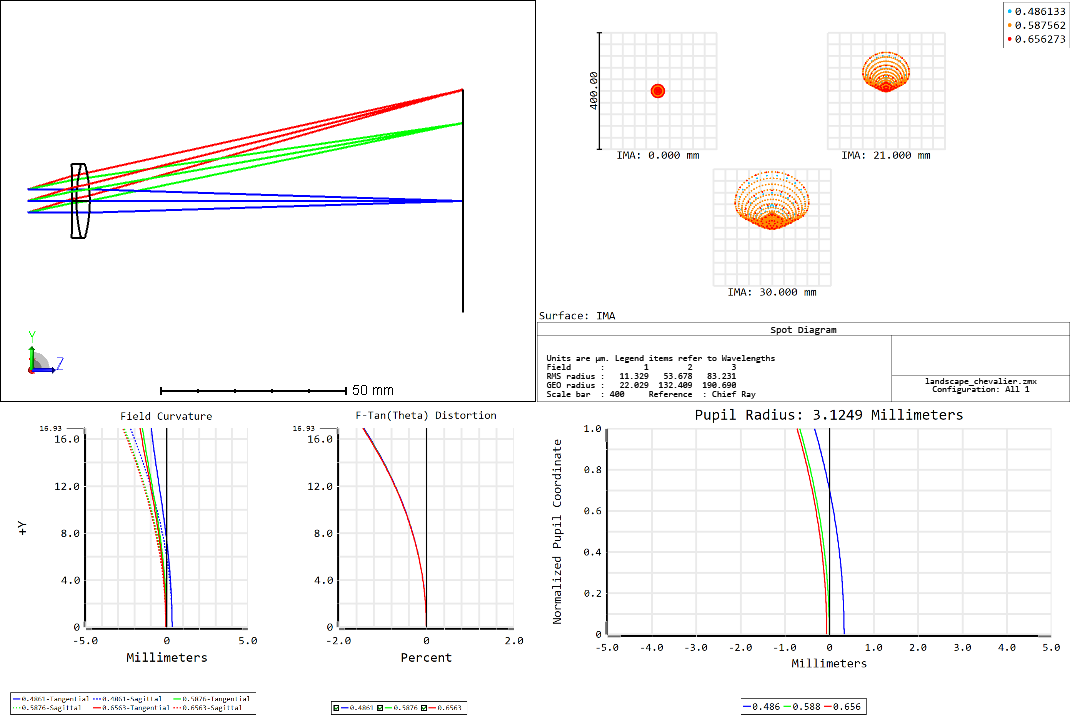
Top left: Lens diagram. Top right: Spot diagram. Bottom (left to right): The field curvature, distortion, and spherical aberration.
What do you see? I see:
- The astigmatism is about the same as the Wollaston landscape, with no clear improvement
- The field curvature is not good (the Petzval sum is large)
- The distortion is about the same, but upon close observation it is actually a little worse
- The chromatic aberration has improved dramatically, this is what we wanted!
Looks like the doublet served its main purpose for colour correction! I have a post on achromatic doublets for a more in-depth look at achromatic doublets.
A variation of the achromatic lens form is by Thomas Grubb, who switched the crown and flint lens of the doublet in 1857.
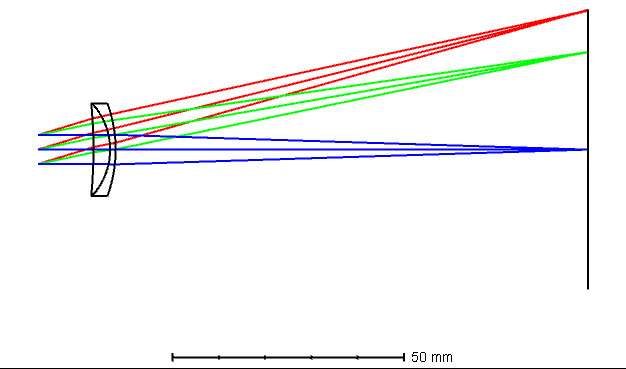
P.S. If you’re interested, I have a massive post on lens design which covers the colour correction in a telescope objective doublet lens. Just click here.
The rapid rectilinear: The elimination of distortion (1866)
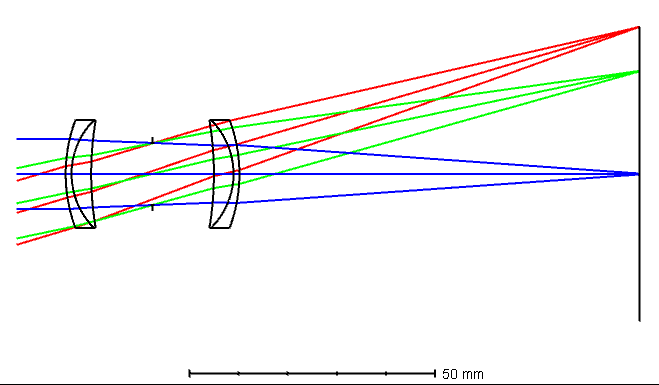
John Henry Dallmeyer and Carl August von Steinheil designed the Rapid Rectilinear lens in 1866 at the same time.
Correcting for colour, correcting the astigmatism, and correcting the distortion had already been established. The obvious thing to do next was to increase the speed of the lens and increase the field of view of the lens.
I’ve designed the Rapid Rectilinear lens for a FOV of 60 degrees, and a focal length of 100mm. The F-number for the lens is F7, which is fast for its time, hence the name rapid. Let’s take a look at the performance of this lens.
The lens design results of the Rapid Rectilinear lens
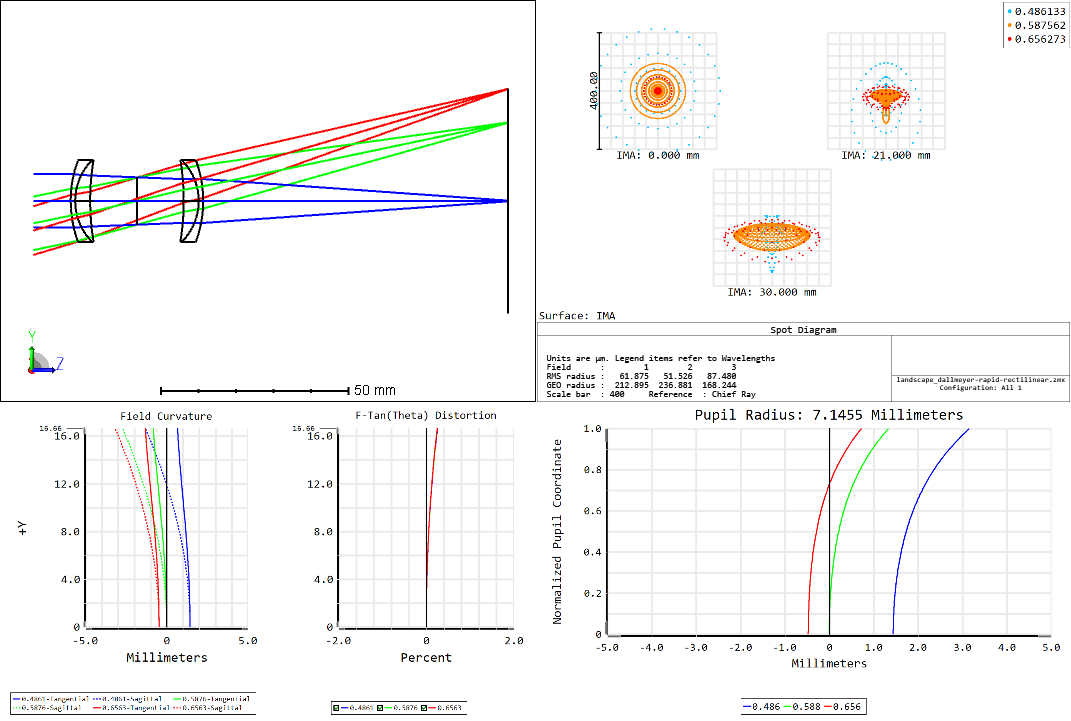
Top left: Lens diagram. Top right: Spot diagram. Bottom (left to right): The field curvature, distortion, and spherical aberration.
What do you see? I see:
- The astigmatism is balanced, and although it is not super great it is okay
- The field curvature is not good (the Petzval sum is large)
- The chromatic aberration is okay, I might have been able to improve this a little more, but I was sticking to “old” glass choices
- The distortion is super flat, due to the symmetry of the lens!
Dallmeyer and Steinheil corrected the distortion while retaining the colour and astigmatism by placing two doublets facing each other, that had similar Abbe number but a different index of refraction. By increasing the curvature of the cemented surface, the spherical aberration is corrected while correcting the colour. Since the optical system is symmetric, the distortion is well corrected and the coma is good as well. The resulting lens was a high performer at F6~F8.
I wonder if Steinheil’s good friend, Philipp Ludwig von Seidel, told him a thing or two about the aberration theory he was developing.
One problem with the Rapid rectilinear lens is the Petzval sum. With the glass choices of the time, the index difference of the glass could not mitigate the large curvature of the lens.
Dallmeyer continued his design by making an asymmetrical version of the rapid rectilinear lens.
Steinheil continued his lens design, and in 1881, developed an Antiplanet lens, which not only corrected the colour, but made negative lenses that generated opposite aberrations that the positive lens generates.
The Protar lens: The dawn of new glass (1890)
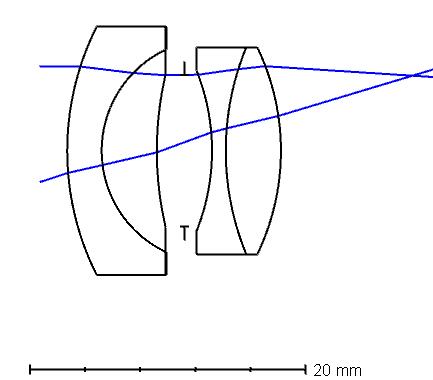
Paul Rudolph was able to design the innovative Protar lens.
Previously, high index lenses negative lenses and low index positive lenses were the only choices for a cemented doublet. The arrival of new glass in 1886 allowed for low index negative lenses and high index positive lens combinations. This allowed for colour correction and Petzval sum correction.
I’ve designed the Protar for a FOV of 60 degrees, and a focal length of 100mm. The F-number for the lens is F8, but a variation of the design can go to F4.5 or so. Let’s take a look at the performance of this lens.
The lens design results of the Protar lens
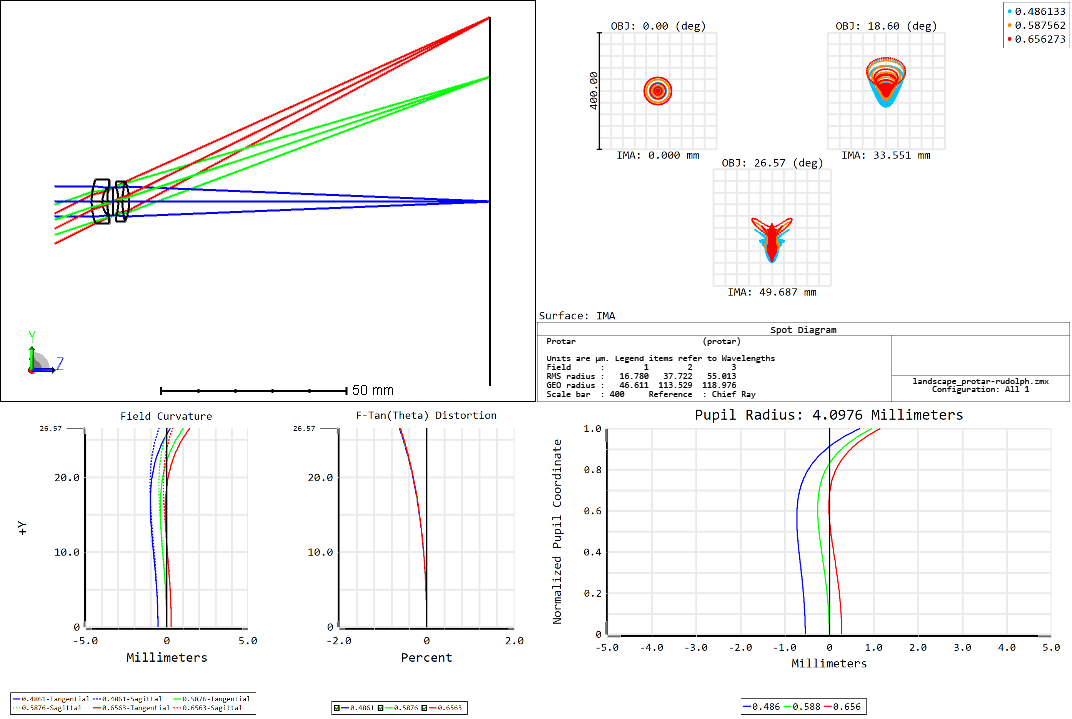
Top left: Lens diagram. Top right: Spot diagram. Bottom (left to right): The field curvature, distortion, and spherical aberration.
What do you see? I see:
- The astigmatism is very good, mostly due to the back elements and new glass choices
- The colour correction is very good, as we retain the properties of colour correction
- The field curvature is very good, it seems like the Petzval sum is small this time!
- The distortion is very good
Looks like everything is very good, we might have a winner!
Rudolph used this “new” glass at the time to design a new cemented doublet for the Protar lens. The front doublet used old glass, but the low index positive lens and the high index negative lens, and corrected the spherical aberration while increasing the astigmatism, and increasing the Petzval sum. The second doublet has new glass, a high index positive lens and low index negative lens, that corrected the astigmatism and the Petzval sum, while increasing the spherical aberration somewhat.
The last example, the Protar, shows the importance of glass choice in the lens design. Even today, glass innovation will vastly change the landscape (pun intended) of optical lens design.
Summary
The early lens design evolution can be summed up as:
- The improvement of the aberrations by changing the lens shape
- The offset of aberrations by placing opposing elements in the lens system
For example, colour is corrected with differing Abbe number glass, distortion is corrected by similar power lenses about the stop. The lenses that achieved this had high performance, and there were rapid improvements due to many intelligent people.
If we go one step further, strategic glass choices to counteract the aberrations skyrockets the performance.
I think that revisiting these classic lenses shows that modern lenses still use a similar method of balancing aberrations albeit in a much more complicated combination.
The landscape lens is an example of how the lens design form plays a big part in the performance and the development of the lens design. Without a clear lens design form, we can’t get a clear lens design.
Did you enjoy a look through the landscape lens and how it relates to optical lens design? I have other exciting posts, and more planned for the future!
Get Your FREE Ultimate Guide to Lens Design using the Spreadsheet Method

With this guide, you can:
-Save valuable time in your lens design process
-Get the Spreadsheets that show the inner workings of lens design
?-Get the fundamentals of lens design in an accessible format
This FREE ebook (and newsletter) will help you uncover the tactics of lens design. It will show you the concepts and strategies of lens design through spreadsheets so that you can take control of your lens design.
We hate SPAM and promise to keep your email safe?100% privacy, and we hate spam. When you sign up, we'll keep you updated usually with one email per week, occasionally up to a few times a week. Unsubscribe at any time.
References and fun links
Wollaston meniscus photos
Dallmeyer Rapid Rectilinear photos
Protar photos
Dallmeyer patent on modified Rapid Rectilinear
Steinhall Antiplanet lens
Protar patent by Rudolph
History of photographic lens design
The Development of the Photographic Objective
The Rapid Rectilinear Lens
Hi,
Thanks for this presentation! Just one comment, I notice the absence of two important types of lens:
1) The Von Rohr lens. It consists of two menisci mounted head to tail, hollow against hollow on either side of the diaphragm, with the 4 curvatures identical in absolute value or at least in pairs. Power is given by the thickness of the meniscus, field curvature is zero and distortion, coma and astigmatism are corrected, as is positional chromatism, due to symmetry, but obviously not longitudinal color and SA. Disadvantage: lens thickness.
2) In the same vein, the periscopic lens with two Wollaston menisci is more compact than the previous one, lower in cost but the curvature of field and astigmatism remain.
With kind regards,
Charles Rydel